Ijraset Journal For Research in Applied Science and Engineering Technology
- Home / Ijraset
- On This Page
- Abstract
- Introduction
- Conclusion
- References
- Copyright
A Review on the Medicinal Significance of Heterocyclic Compounds
Authors: Deepak Thakur, Vikas Kumar, Sandeep Kumar Tyagi, Ravindra Singh Parmar
DOI Link: https://doi.org/10.22214/ijraset.2023.54569
Certificate: View Certificate
Abstract
Heterocyclic chemistry focuses on the study of organic compounds containing at least one ring structure with atoms of at least two different elements. These compounds are pervasive in various chemical disciplines and have significant importance in life processes. They are found in natural products and are of great interest to industries like pharmaceuticals and agrochemicals. Heterocyclic compounds with diverse structures can be synthesized using various methods, enabling the design of molecules with desired properties. Over 90% of newly approved drugs contain heterocyclic structures, underscoring their crucial role in medicinal chemistry. This interdisciplinary field is essential for understanding and manipulating biological processes and is indispensable in drug discovery and development.
Introduction
I. INTRODUCTION
Heterocyclic compounds, diverse organic chemicals with ring structures composed of atoms from different elements, are essential in chemistry and biology. They are highly accessible through various synthesis methods, enabling the creation of diverse structures. Heterocyclic chemistry is a captivating and evolving field that interests scientists from different disciplines. Synthetic methodologies, including traditional and modern techniques, have expanded the scope of heterocyclic chemistry, providing a wide range of structures for study [1].
Heterocyclic compounds have gained significant attention from the pharmaceutical and agrochemical industries due to their prevalence in nature and potent biological activities. Many natural products, including alkaloids, vitamins, and antibiotics, contain heterocyclic structures. These compounds exhibit strong pharmacological or pesticidal properties, making them invaluable in drug discovery and crop protection. Over 90% of newly approved drugs incorporate heterocyclic motifs, highlighting their importance in medicinal chemistry. Heterocyclic compounds possess diverse biological potential, demonstrating activities such as antifungal and anti-inflammatory effects, and can be utilized for studying biological processes and developing therapeutic interventions.
The interface between chemistry and biology unleashes the full potential of heterocyclic compounds. This interdisciplinary domain enables exploration of molecular interactions, elucidation of biological mechanisms, and design of optimized compounds. Collaboration between chemists and biologists leads to structure-activity relationships, understanding of drug action, and novel therapeutic strategies. The synergy between chemistry and biology has driven groundbreaking advancements in drug development, precision medicine, and personalized therapies. Heterocyclic compounds, with their diverse structures and biological activities, hold a central position in chemistry and biology [2]. Innovative synthesis methodologies offer vast possibilities for creating novel compounds. The pharmaceutical and agrochemical industries harness the potential of heterocyclic compounds, with a majority of approved drugs incorporating them. Continued exploration of these compounds at the chemistry-biology interface promises new insights, discoveries, and applications, paving the way for future advancements in academia and industry.
II. BIOLOGICAL ACTIVITY OF HETEROCYCLIC COMPOUNDS
Heterocyclic compounds exhibit diverse biological potential. Indole-based drugs possess potent anti-inflammatory effects, while imidazole derivatives demonstrate antifungal efficacy. These compounds interact with biological targets, regulating their functions and making them valuable tools for understanding biology and developing therapies. The chemistry-biology interface unleashes the full potential of heterocyclic compounds, enabling the study of molecular interactions, biological processes, and the creation of optimized substances. Collaboration between chemists and biologists drives advancements in drug development, precision medicine, and personalized therapy.
Ongoing research at this interface continues to uncover new compounds and their activities, offering scientific insights and applications in various fields [3-4]. Heterocyclic compounds, organic compounds with non-carbon atoms in their ring structures, display a broad range of processes in biology. Examples include antibacterial and antifungal effects, anticancer properties, anti-inflammatory action, neurological activity, antiviral potential, and enzyme inhibition. Heterocyclic compounds are vital in drug discovery due to their ability to interact with specific targets and produce various therapeutic effects.
A. Antifungal Activity
Heterocyclic compounds offer a rich source of antifungal agents with diverse structures and mechanisms of action. Their potential to disrupt essential fungal processes and inhibit growth makes them attractive candidates for the development of novel antifungal drugs. Through structural optimization, combination therapies, and innovative approaches, researchers are striving to overcome challenges and improve the efficacy, spectrum of activity, and safety profiles of heterocyclic antifungal agents. As our understanding of fungal biology and drug design continues to expand, heterocyclic compounds hold tremendous potential for the development of next-generation antifungal therapies, offering hope for improved treatments and better. Here are some examples of heterocyclic compounds with antifungal activity:
Synthesis of a number of new chitosan derivatives and their FTIR, 1H-NMR, and elemental analyses. In the meanwhile, chitosan derivatives' antioxidant efficacy was tested in vitro. In vitro hyphal measuring was used to gauge their antifungal capabilities against two plant pathogenic fungus (Colletotrichum lagenarium and Phomopsis asparagi), and all of the products demonstrated outstanding antifungal activity [5].
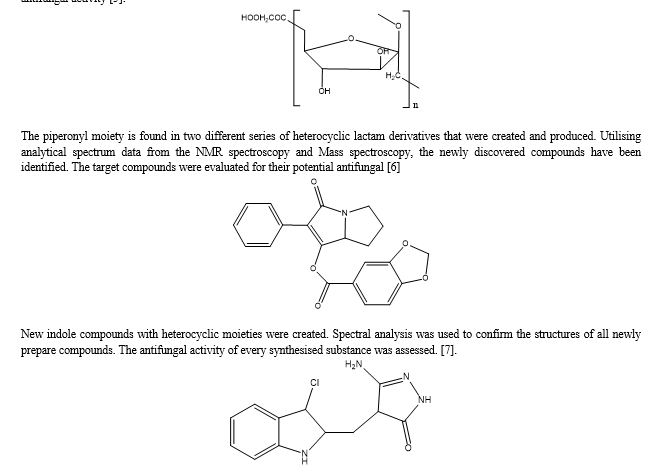
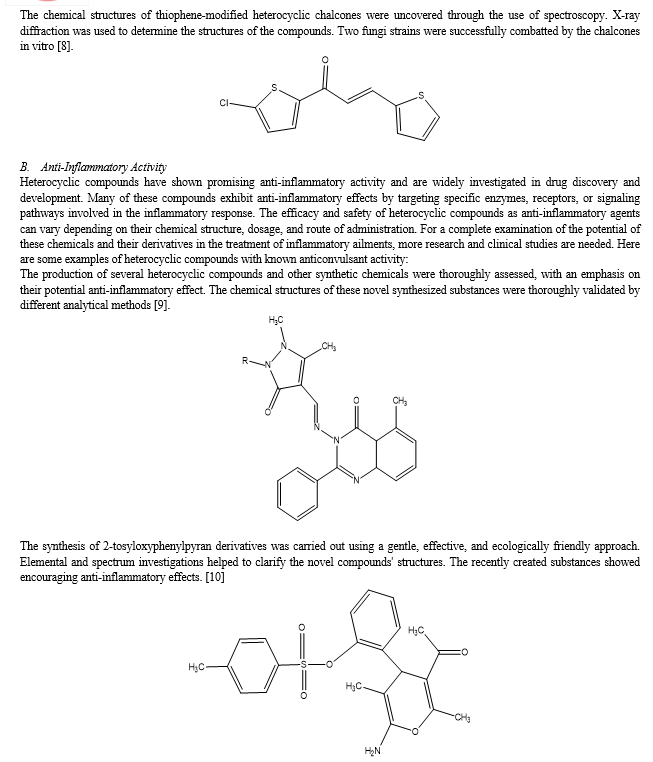
C. Antibacterial Activity
Heterocyclic compounds have been extensively investigated for their antibacterial activity and have proven to be valuable in the development of antibacterial agents. Several classes of heterocyclic compounds have demonstrated significant antibacterial properties. The specific mechanisms of antibacterial action and spectrum of activity can vary depending on the heterocyclic compound and its structural modifications. Additionally, the emergence of antibiotic resistance poses a significant challenge in the field of antibacterial drug development. Ongoing research and the exploration of novel heterocyclic compounds are necessary to combat drug-resistant bacterial infections. Here are some examples of heterocyclic compounds with known anticonvulsant activity:
To figure out whether or not they might have antimicrobial effects, the pyran derivatives synthesized using this approach were further examined. The susceptibility or resistance of two bacterial strains, Escherichia coli (E. coli) and Bacillus cereus (B. cereus), to the synthesized pyran compounds, was examined in vitro. [11].
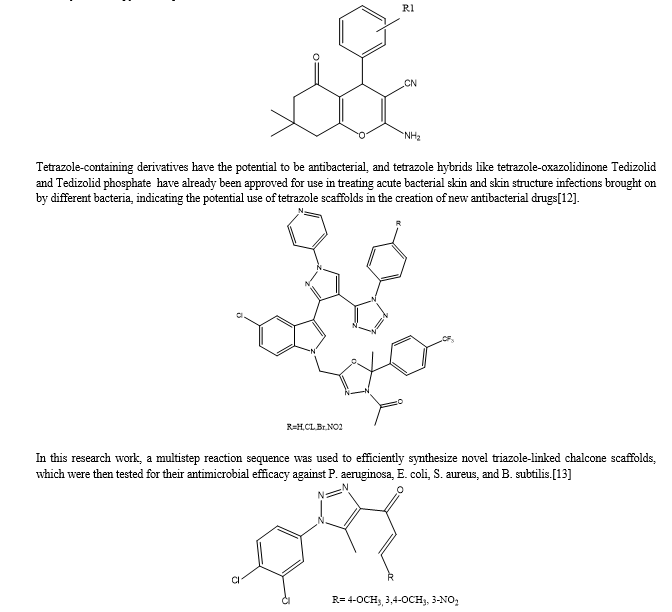
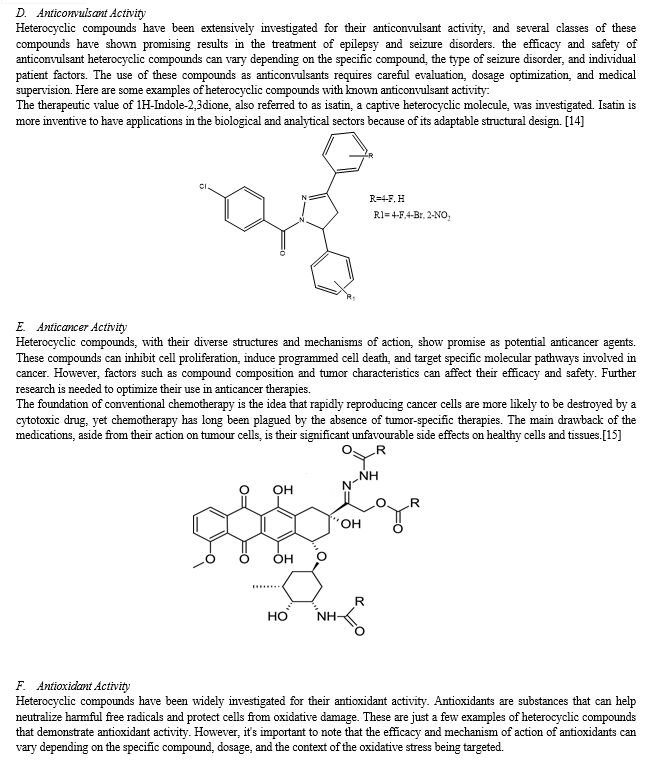
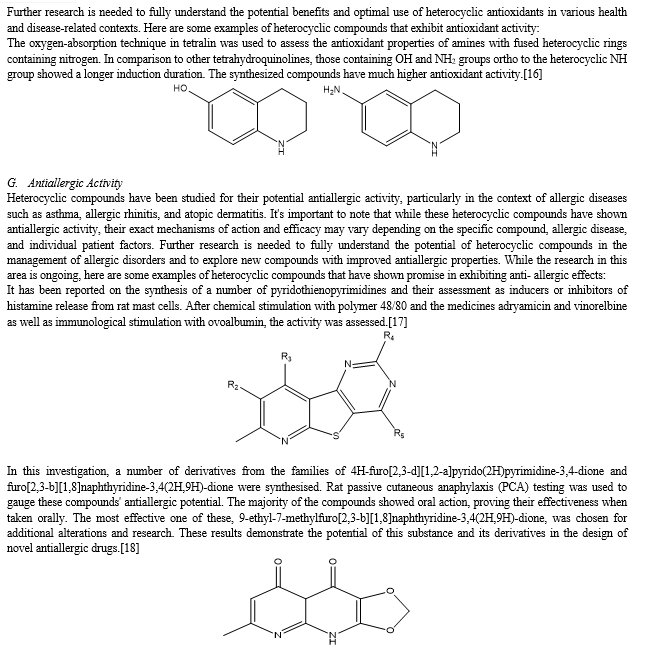
Conclusion
III. CONCLUSION Heterocyclic compounds have demonstrated remarkable biological activity and continue to hold significant potential in various areas of research and application. These compounds have played a crucial role in drug discovery, providing numerous therapeutically important molecules for the treatment of diseases such as cancer, infectious diseases, and neurological disorders. They have shown diverse mechanisms of action, including inhibition of enzymes, modulation of receptors, interference with signaling pathways, and disruption of cellular processes, making them valuable tools for targeted therapy and multi-target drug design. Heterocyclic compounds have also made significant contributions to the field of antimicrobial research, particularly in combating antibiotic resistance. The exploration of novel heterocyclic structures and modifications may lead to the development of more potent and selective antimicrobial agents that can combat drug-resistant pathogens effectively. Furthermore, these compounds have the potential to find applications in agricultural settings, offering environmentally friendly solutions for weed and pest control. Looking ahead, the future prospects of heterocyclic compounds as biological agents are promising. Advances in synthetic methodologies, computational tools, and our understanding of disease mechanisms will fuel the discovery and development of novel compounds with improved efficacy, selectivity, and reduced toxicity. Additionally, the integration of heterocyclic compounds into functional materials and the use of these compounds in theranostics highlight their versatility and potential for a wide range of applications. However, it is essential to address challenges such as optimization of compound properties, drug delivery strategies, and minimizing adverse effects to fully harness the potential of heterocyclic compounds as biological agents. Continued research, collaboration, and innovation in this field will pave the way for the development of new and more effective therapies, materials, and agricultural solutions that can benefit human health and the environment.
References
[1] Zapp, M. L., Young, D., Kumar, A., Singh, R. J., Boykin, D. W., Wilson, W. D., & Green, M. F. (1997). Modulation of the rev-RRE interaction by aromatic heterocyclic compounds. Bioorganic & Medicinal Chemistry. https://doi.org/10.1016/s0968-0896(97)00063-1 [2] Bhat, Z. S., Rather, M. A., Maqbool, M., Lah, H. U., Yousuf, S. K., & Ahmad, Z. (2017). ?-pyrones?: Small molecules with versatile structural diversity reflected in multiple pharmacological activities-an update. Biomedicine & Pharmacotherapy, 91, 265–277. https://doi.org/10.1016/j.biopha.2017.04.012 [3] Craik, D. J., Fairlie, D. P., Liras, S., & Price, D. (2012). The Future of Peptide-based Drugs. Chemical Biology & Drug Design, 81(1), 136–147. https://doi.org/10.1111/cbdd.12055 [4] Wang, L., O’Connor, D. H., Rinklebe, J., Kim, K., Kim, K., Shen, Z., & Hou, D. (2020). Biochar Aging: Mechanisms, Physicochemical Changes, Assessment, And Implications for Field Applications. Environmental Science & Technology, 54(23), 14797–14814. https://doi.org/10.1021/acs.est.0c04033 [5] Mi, Y., Zhang, J., Chen, Y., Sun, X., Tan, W., Li, Q. X., & Guo, Z. (2020). New synthetic chitosan derivatives bearing benzenoid/heterocyclic moieties with enhanced antioxidant and antifungal activities. Carbohydrate Polymers, 249, 116847. https://doi.org/10.1016/j.carbpol.2020.116847 [6] Wang, S., Bao, L., Song, D., Wang, J., & Cao, X. (2019). Heterocyclic lactam derivatives containing piperonyl moiety as potential antifungal agents. Bioorganic & Medicinal Chemistry Letters, 29(20), 126661. https://doi.org/10.1016/j.bmcl.2019.126661 [7] Sayed, M., El-Dean, A. M. K., Ahmed, M., & Hassanien, R. (2018). Synthesis of some heterocyclic compounds derived from indole as antimicrobial agents. Synthetic Communications, 48(4), 413–421. https://doi.org/10.1080/00397911.2017.1403627 [8] Bari, A., Grenier, D., Azelmat, J., Syed, S. A., Al-Obaid, A. M., & Hosten, E. C. (2019). Synthesis and anti?inflammatory activity of diversified heterocyclic systems. Chemical Biology & Drug Design, 94(4), 1750–1759. https://doi.org/10.1111/cbdd.13576 [9] Ming, L. Y., Jamalis, J., Al-Maqtari, H. M., Rosli, M. M., Murugesan, S., Chander, S., & Fun, H. (2017). Synthesis, characterization, antifungal activities and crystal structure of thiophene-based heterocyclic chalcones. Chemical Data Collections, 9–10, 104–113. https://doi.org/10.1016/j.cdc.2017.04.004 [10] Khodairy, A., Ali, A. B., Aboelez, M. O., & El-Wassimy, M. T. (2017). One-Pot Multicomponent Synthesis of Novel 2-Tosyloxyphenylpyrans under Green and Conventional Condition with Anti-inflammatory Activity. Journal of Heterocyclic Chemistry, 54(2), 1442–1449. https://doi.org/10.1002/jhet.2730 [11] Dutta, A., Rahman, N., Kumar, J. E., Rabha, J., Phukan, T., & Nongkhlaw, R. (2021). Catalyst-free UV365-assisted synthesis of pyran annulated heterocyclic scaffolds and evaluation of their antibacterial activities. Synthetic Communications, 51(2), 263–278. https://doi.org/10.1080/00397911.2020.1825741 [12] Gao, F., Xiao, J., & Huang, G. (2019). Current scenario of tetrazole hybrids for antibacterial activity. European Journal of Medicinal Chemistry, 184, 111744. https://doi.org/10.1016/j.ejmech.2019.111744 [13] Santosh, R., Selvam, M. K., Kanekar, S., & Nagaraja, G. K. (2018). Synthesis, Characterization, Antibacterial and Antioxidant Studies of Some Heterocyclic Compounds from Triazole?Linked Chalcone Derivatives. ChemistrySelect, 3(23), 6338–6343. https://doi.org/10.1002/slct.201800905 [14] Pradeep, S. D., & Mohanan, P. (2022). Advancements in Schiff Bases of 1H-Indole-2,3dione: A Versatile Heterocyclic Compound in Pharmacological Field. Mini-reviews in Organic Chemistry, 20(1), 45–54. https://doi.org/10.2174/1570193x19666220309142035 [15] Jó?wiak, M. O. T., Filipowska, A., Fiorino, F., & Struga, M. (2020). Anticancer activities of fatty acids and their heterocyclic derivatives. European Journal of Pharmacology, 871, 172937. https://doi.org/10.1016/j.ejphar.2020.172937 [16] Nishiyama, T., Hashiguchi, Y., Sakata, T., & Sakaguchi, T. (2003). Antioxidant activity of the fused heterocyclic compounds, 1,2,3,4-tetrahydroquinolines, and related compounds—effect of ortho-substituents. Polymer Degradation and Stability, 79(2), 225–230. https://doi.org/10.1016/s0141-3910(02)00285-9 [17] Quintela, J. M., Peinador, C., Veiga, C., González, L., Botana, L. M., Alfonso, A., & Riguera, R. (1998). Synthesis and antiallergic activity of pyridothienopyrimidines. Bioorganic & Medicinal Chemistry, 6(10), 1911–1925. https://doi.org/10.1016/s0968-0896(98)00150-3 [18] Kuo, S., Tsai, S., Li, H., Wu, C., Ishii, K., & Nakamura, H. (1988). Studies on heterocyclic compounds. IX. Synthesis and antiallergic activity of furo(2,3-b)(1, 8)naphthyridine-3,4(2H, 9H)-diones and 4H-furo(2,3-d)pyrido(1,2-a)pyrimidine-3,4(2H)-diones. Chemical & Pharmaceutical Bulletin, 36(11), 4403–4407. https://doi.org/10.1248/cpb.36.4403
Copyright
Copyright © 2023 Deepak Thakur, Vikas Kumar, Sandeep Kumar Tyagi, Ravindra Singh Parmar. This is an open access article distributed under the Creative Commons Attribution License, which permits unrestricted use, distribution, and reproduction in any medium, provided the original work is properly cited.

Download Paper
Paper Id : IJRASET54569
Publish Date : 2023-07-01
ISSN : 2321-9653
Publisher Name : IJRASET
DOI Link : Click Here
 Submit Paper Online
Submit Paper Online

